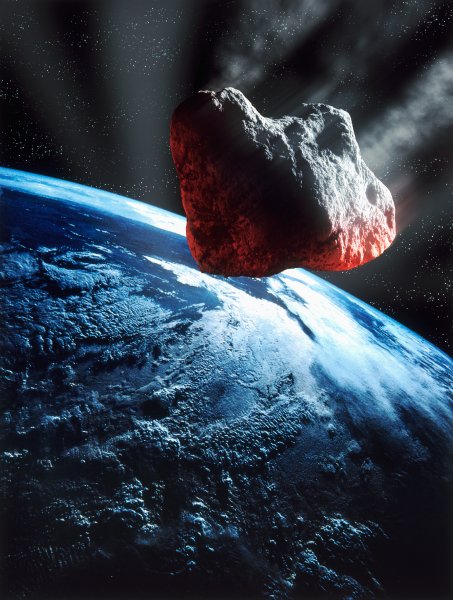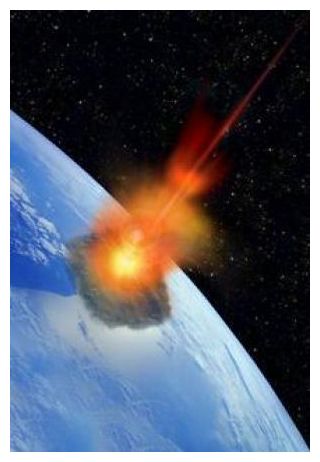Last year when I first wrote A Different Kind of Climate catastrophe I pointed out that one of the major flaws in the YD impact hypothesis as written was that the original authors weren't working from a valid astronomical model. In fact, they were all over the place with their speculation as to just what the nature of the catastrophe 12,900 years ago may have been, or what had hit us. That's what got them into trouble and gave opponents to the hypothesis the rallying cry of "Where's the crater?" But to be fair, they were citing the work of Toon et al in their estimate that it would take a four mile wide bolide to account for a continent wide debris layer. And at the time, Toon et al's work on impact scaling was respected as the state of the science in the impact research community.
I think it's going to wind up being seen as ironic that the physicist who came out as the chief skeptic of the hypothesis, Mark Boslough, and who correctly pointed out that it is physically impossible for a four mile wide bolide to have enough time in the atmosphere to break up completely and scatter fragments, and debris, over a continent sized area without making a good sized crater somewhere just happens to be the same scientist who first considered that very large airburst phenomena might be capable of significant melting, and efficient ablation the surface of the Earth without making a crater.
Since 2007 the YD Impact hypothesis has come under fire from numerous skeptics. And it finds a current update, and a new iteration in the work of Isabel Israde-Alcántara et al and the new PNAS paper Evidence from central Mexico supporting the Younger Dryas extraterrestrial impact hypothesis.
All of the arguments of the skeptics to date have been addressed in this new version. But more importantly for my own work here is that everything I have been saying about the potential for cluster airburst events, airburst phenomena and the fact that the hypothesis should be updated to be in line with Clube & Napier's work on the Taurid complex is supported in this new paper.
As of this date though, I think I remain the only researcher who contends that very large airbursts have produced significant ablative geomorphology in the geologically recent past. And that the YD event did indeed produce significant planetary scarring. It just wasn't anything that anyone has ever imagined as possible in an impact event.
I immediately seized upon the work of W.M. Napier last year when I cited his paper titled Paleolithic extinctions and the Taurid Complex here in this article in my own amateur expression of the hypothesis, and my description of what I interpret as some of the planetary scarring of the event. And now it's official: The Taurid Complex is the stated astronomical model for the event.
From the paper:
Comets.Impact research is an infant science. And thanks to poor funding for Near Earth Object research, and for impact science in general, we don't have a very good handle yet on the variety or quantity, of objects out there that might threaten our world, much less a comfortable understanding of the different kinds of devastation that might be released in a catastrophic impact besides what we see in a generic, single, solid-bolide, crater forming, kinetic impact event. But in light of the new data published in this new paper I think it's time to realize that craters are not the only kind of planetary scarring we can expect in an impact event. And this new work clearly recognizes that single lone bolides, are not the only kind of catastrophic impact event we can expect in the future.
Based upon astrophysical observations and modeling, Napier proposed that YDB impact markers were produced when Earth encountered a dense trail of material from a large already fragmented comet. His model predicts cluster airbursts and/or small cratering impacts that could account for the wide distribution of YD impact debris across more than 10% of the planet, including Cuitzeo. Most comets eventually break up as they transit the inner solar system, and previously unknown fragmented comets are discovered by space-borne telescopes, such as the Solar and Heliospheric Observatory, on average every 4 y. As evidence, Earth is bombarded at an average rate of once every 5 d by one of 72 meteor streams or "showers," massive clouds of debris from fragmented comets. These well-known meteor showers, e.g., Perseids, Geminids, Taurids, etc., are highly dispersed, but in the recent geologic past, each stream was far more condensed, containing many large, potentially destructive fragments. Currently, the Taurid Complex contains 19 large near-earth Apollo asteroids, with diameters ranging from approximately 1.5 km to approximately 5 km. None of these currently threatens Earth but may do so in the future.
Large clusters of smaller fragments do indeed impact planets of the inner solar system from time to time. And the belief that we can accurately estimate the age of a planetary surface by counting the number of craters is in trouble.





I am currently in college studying physics. When I graduate, I will have a bachelor of science in Physics. Afterwards, I will continue my education to get myself well associated with astrophysics and astronomy. It is my dream to use my understanding of science and mathematics to defend our home from these potentially deadly Near Earth Objects.